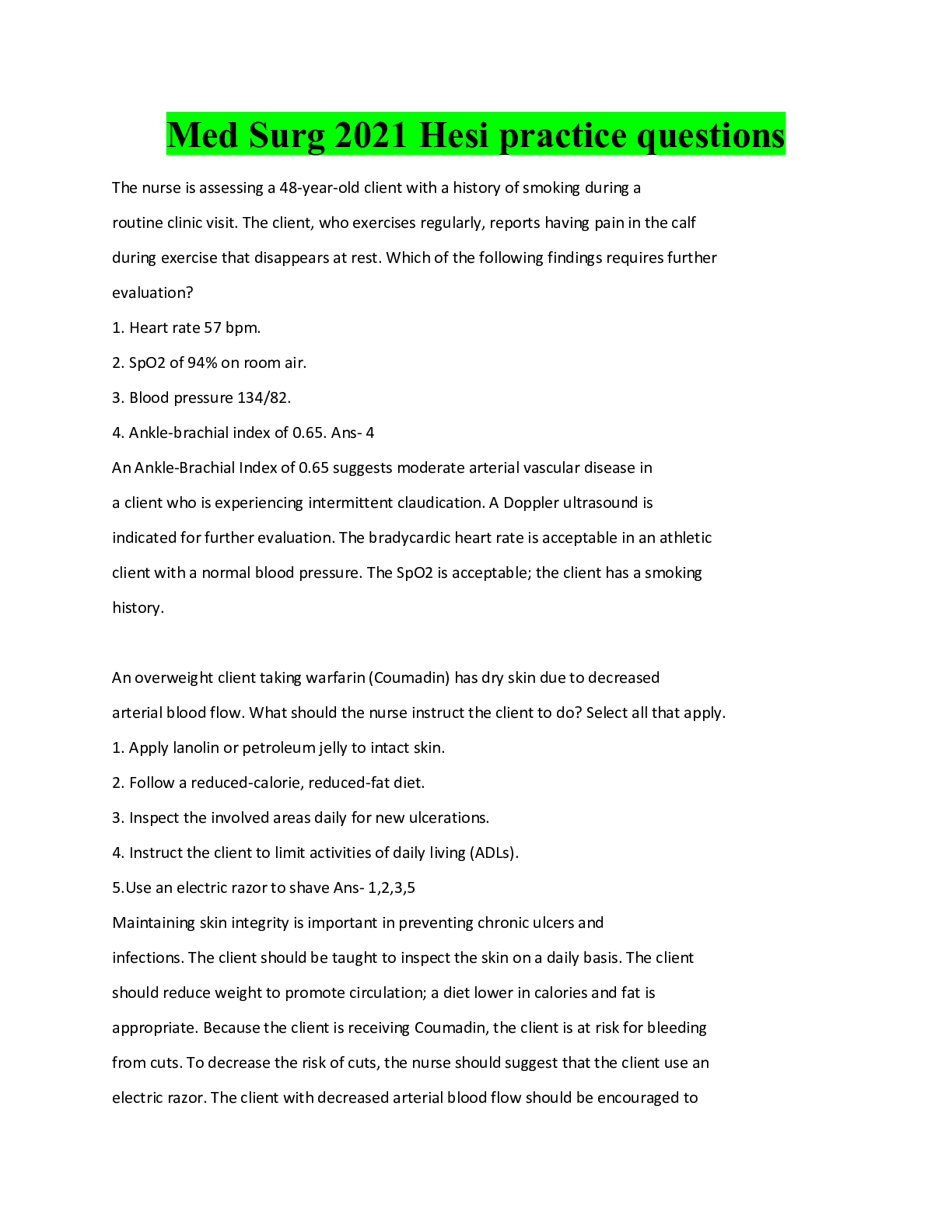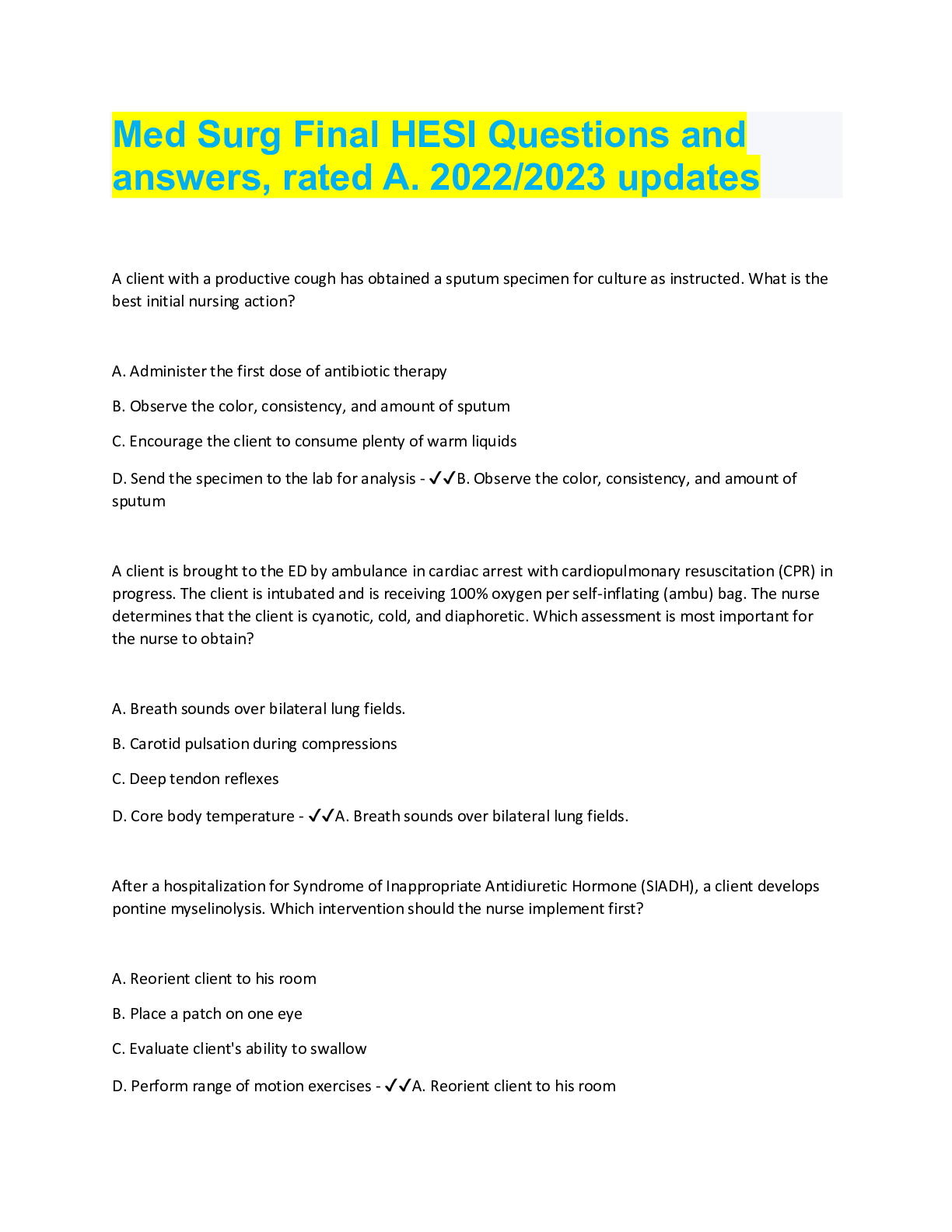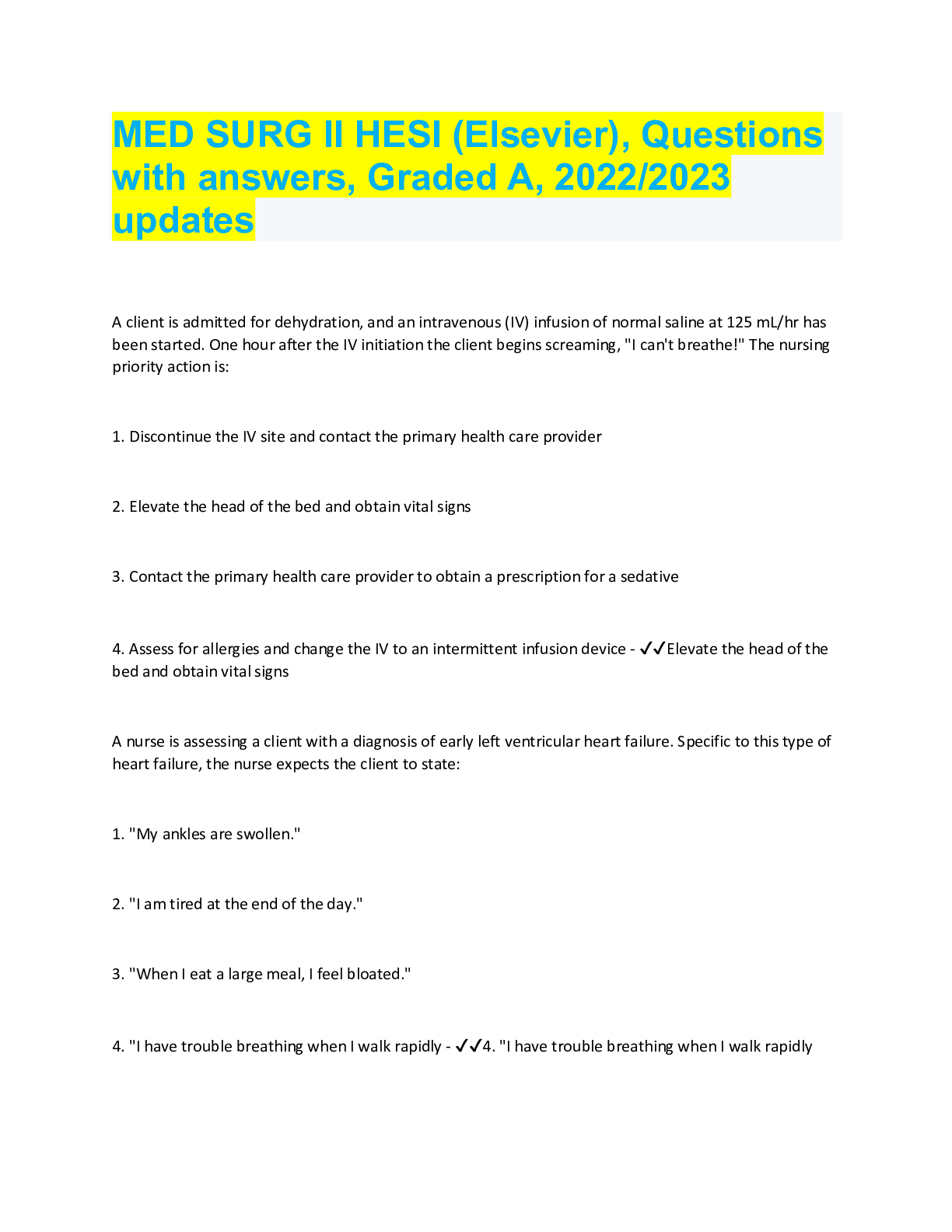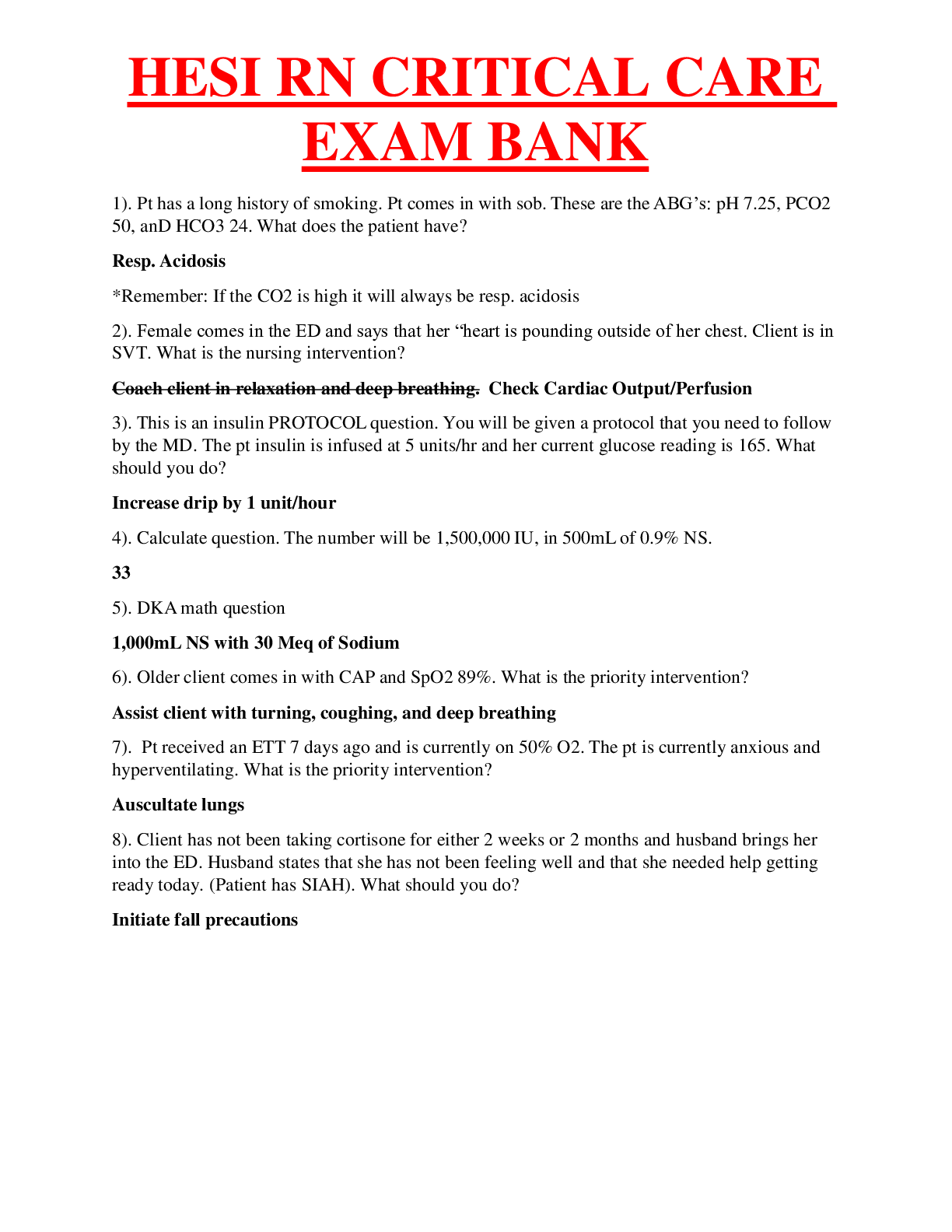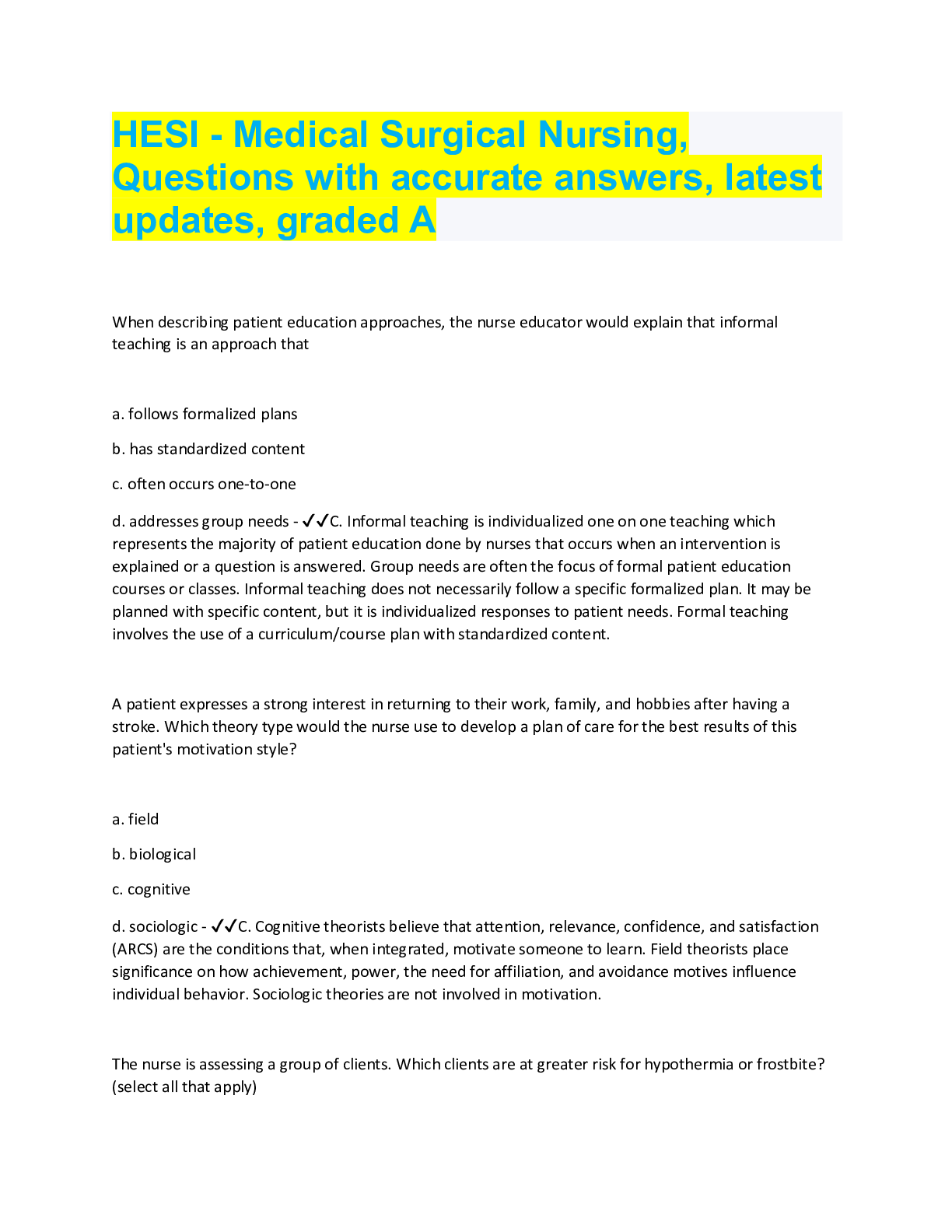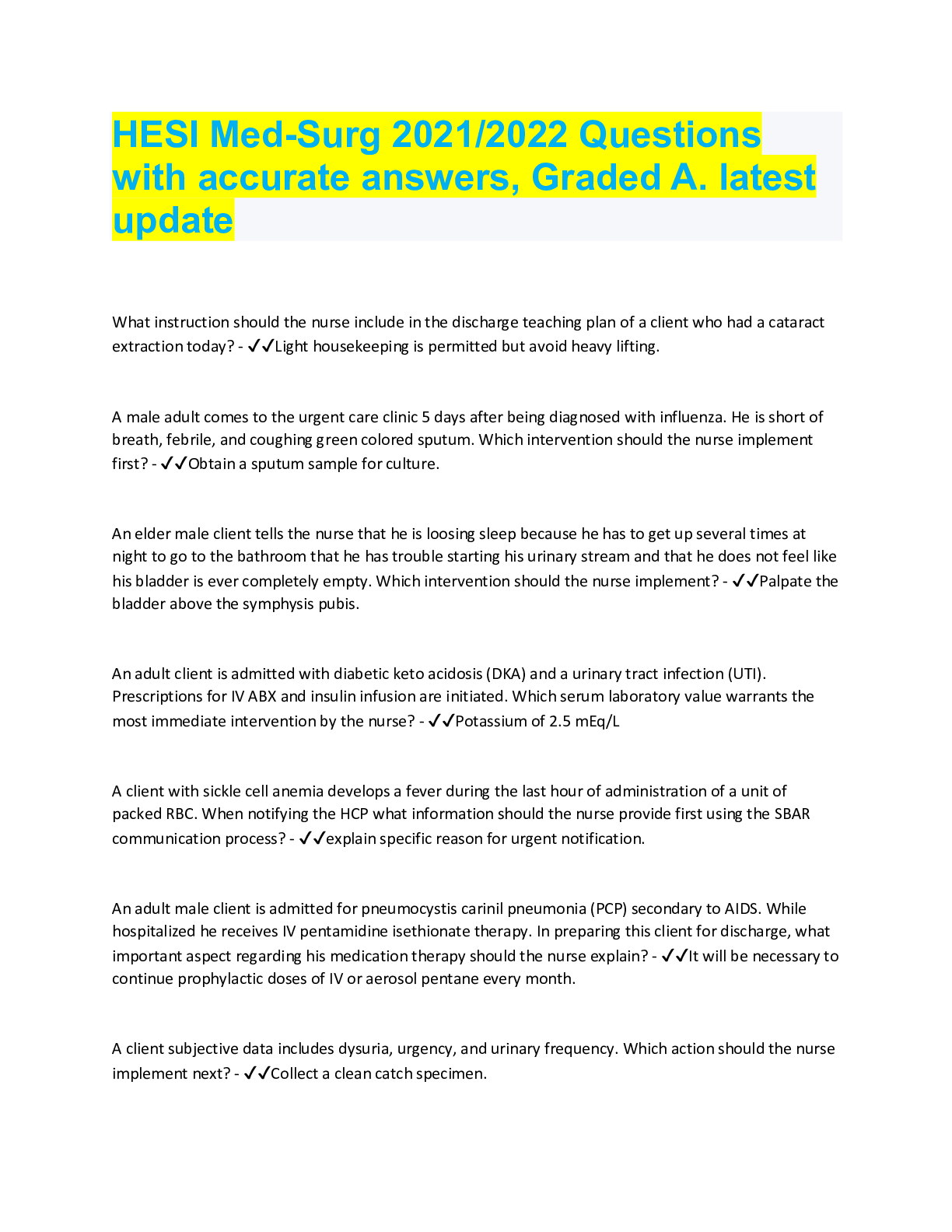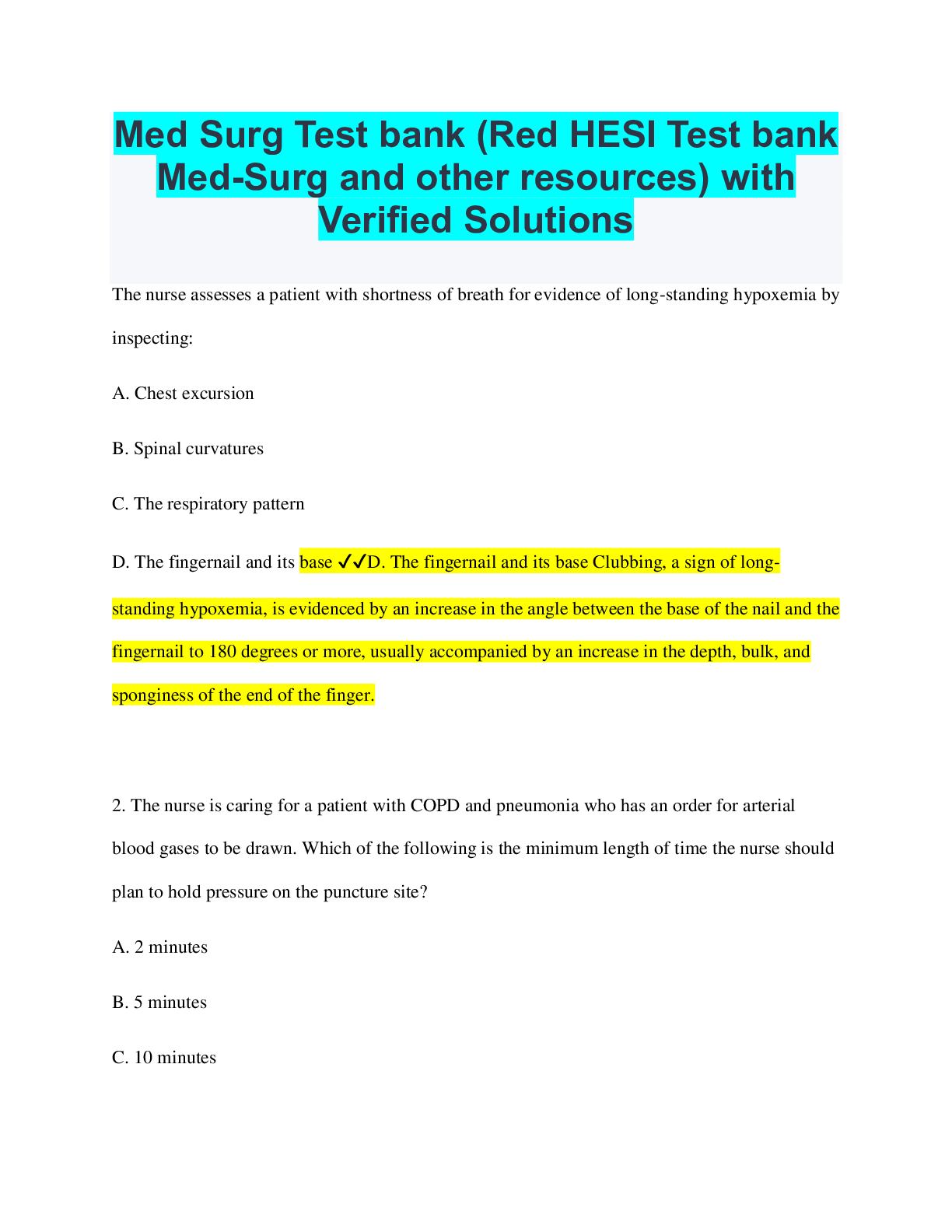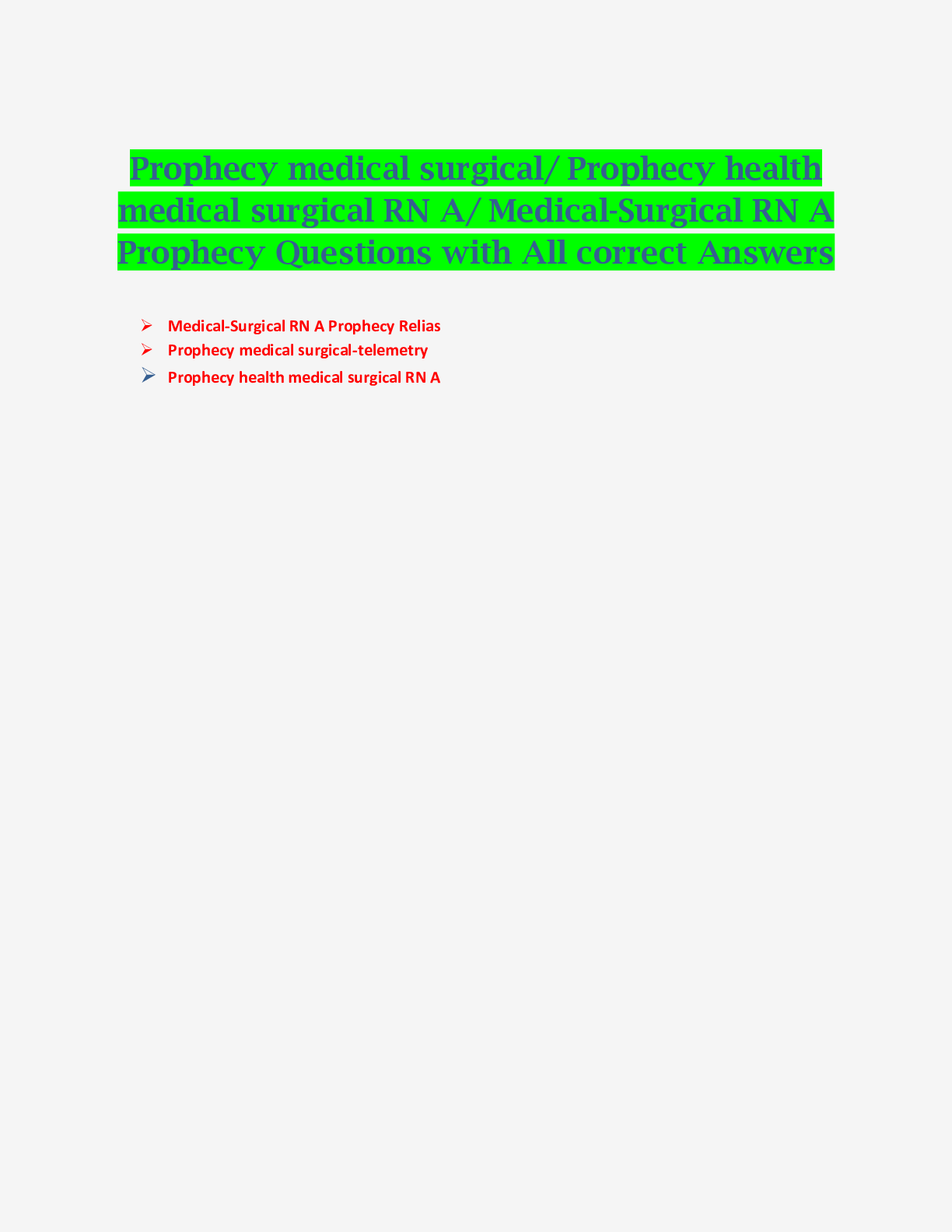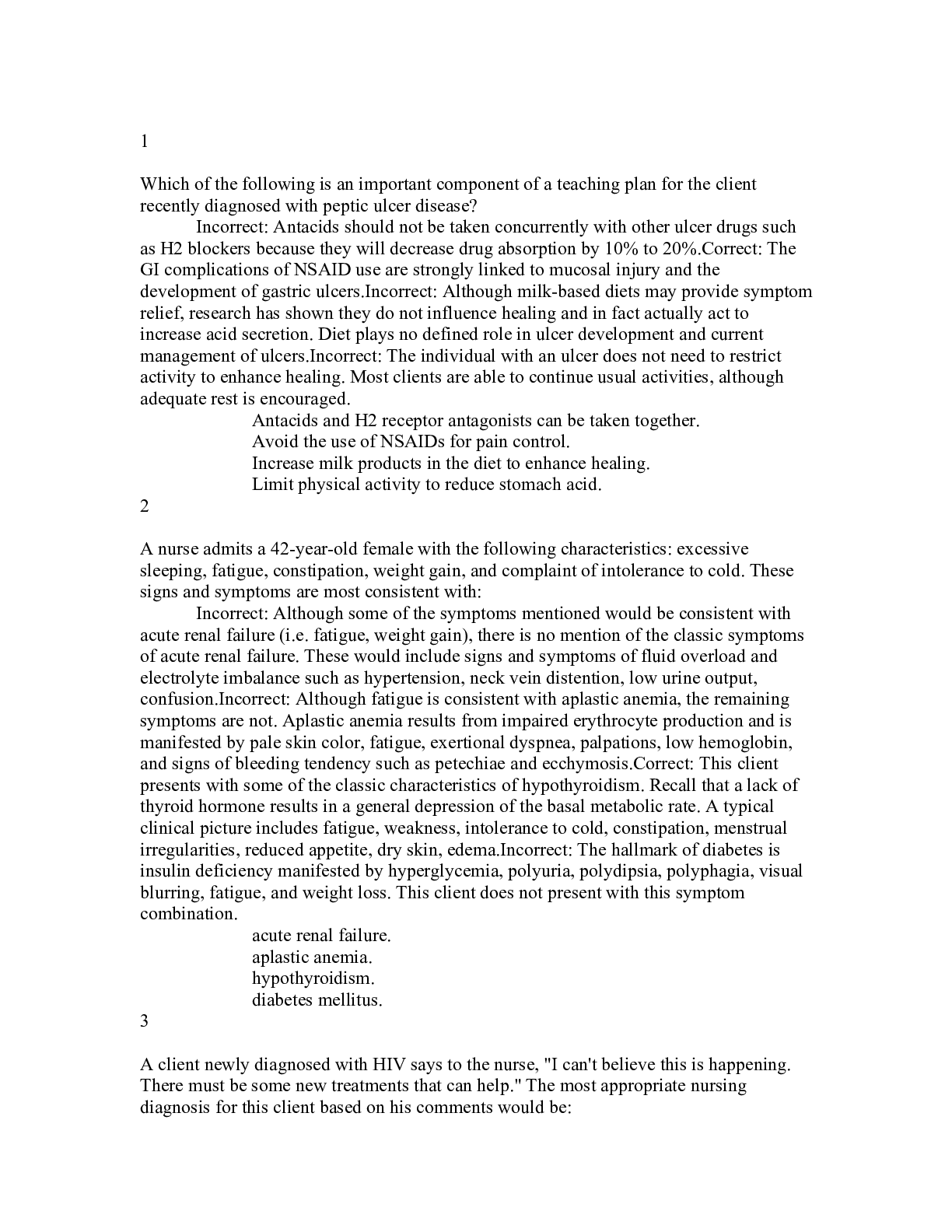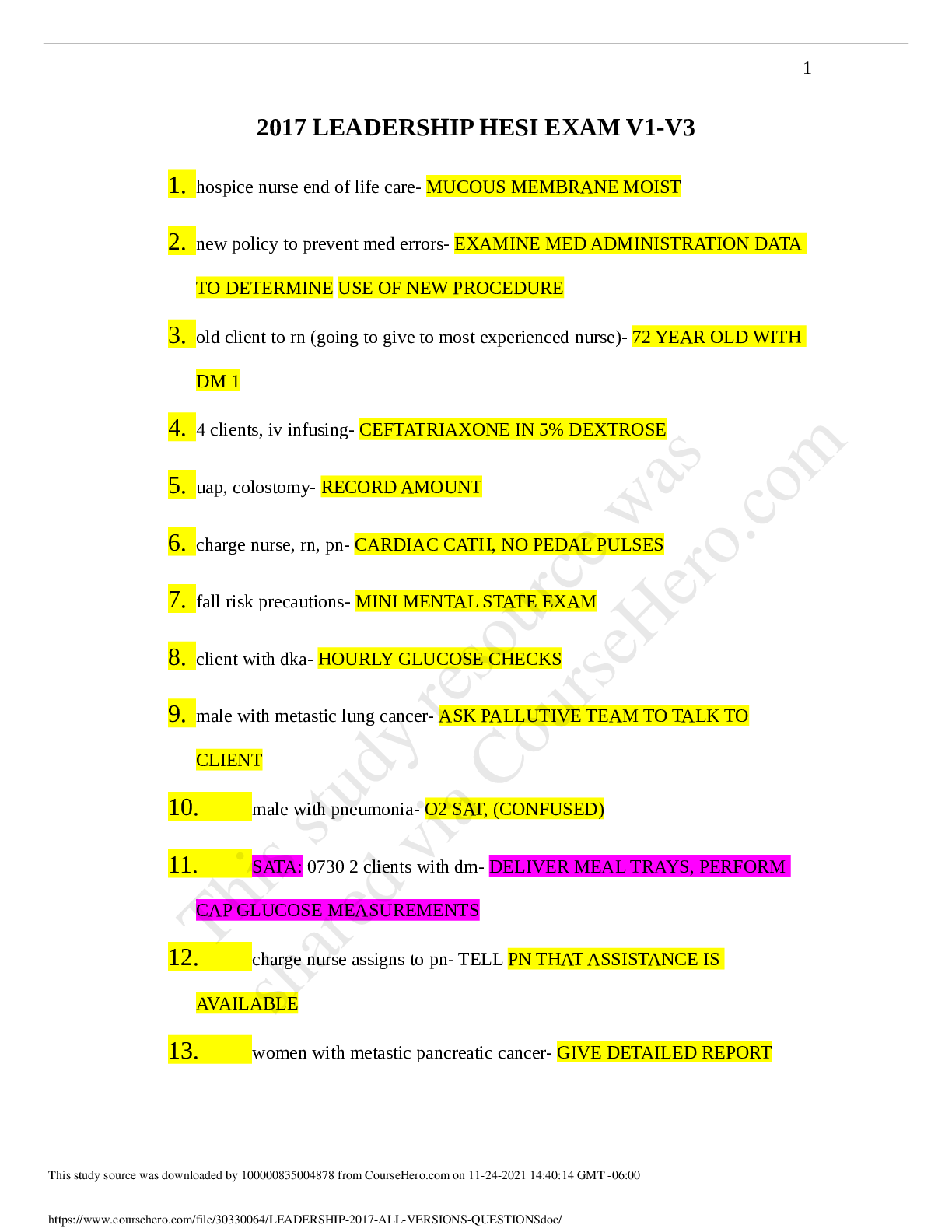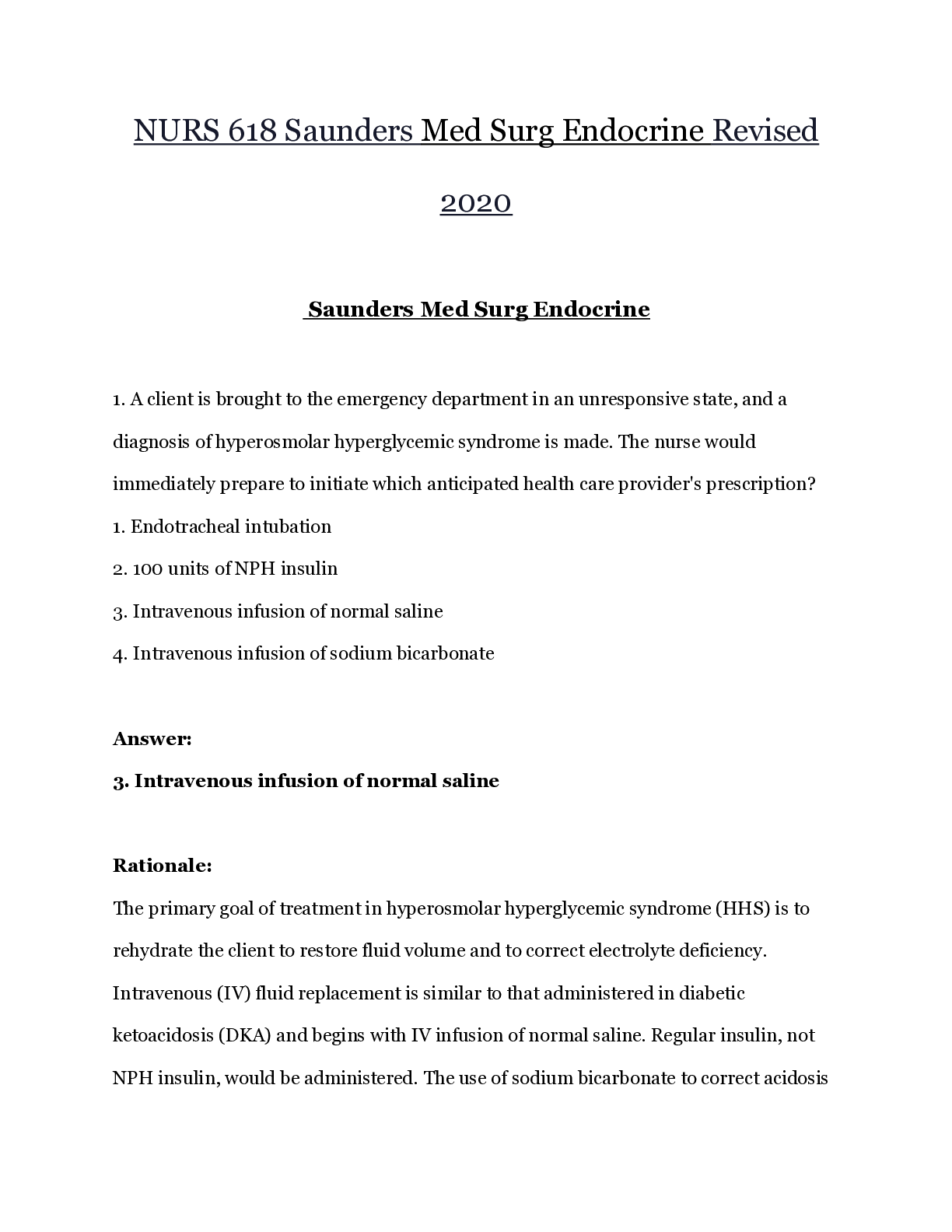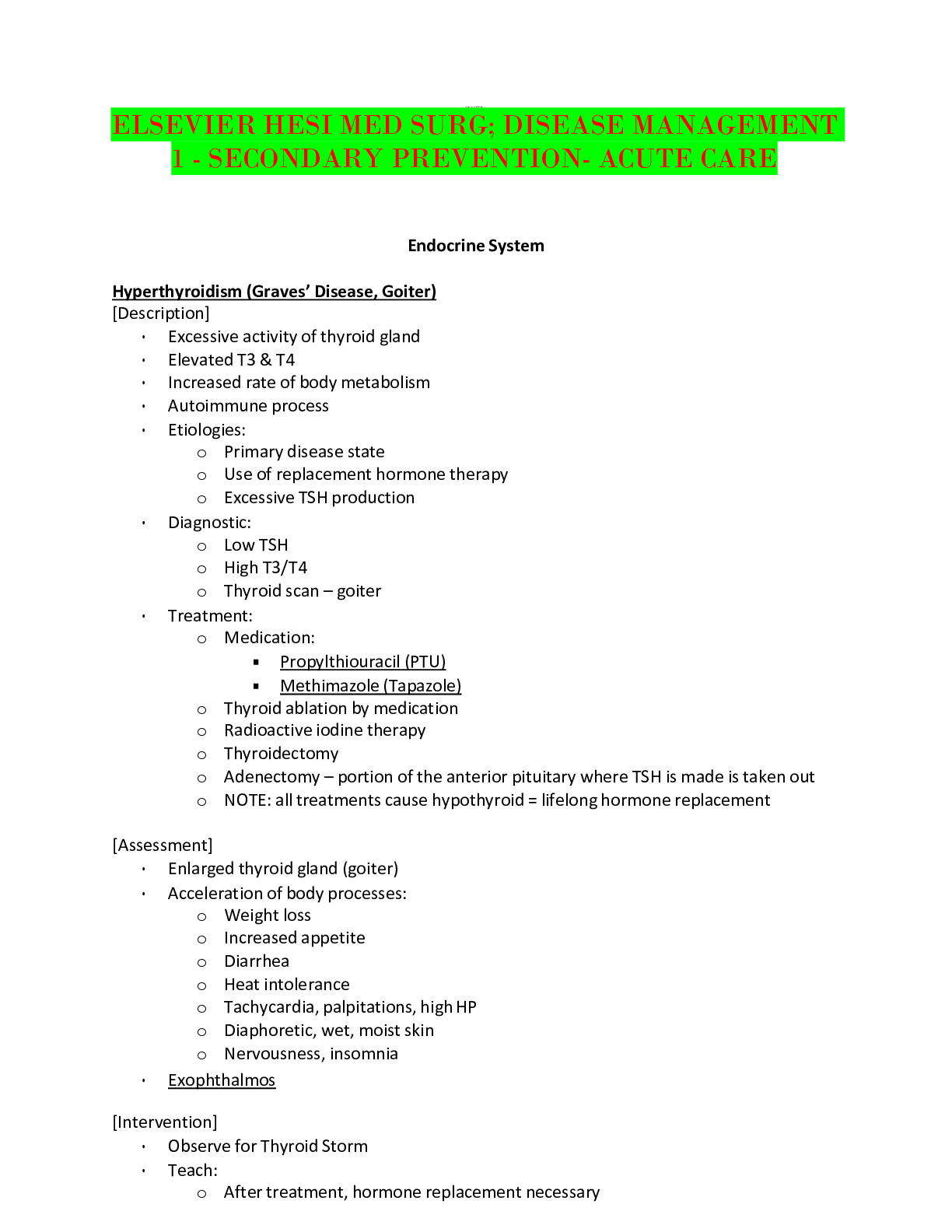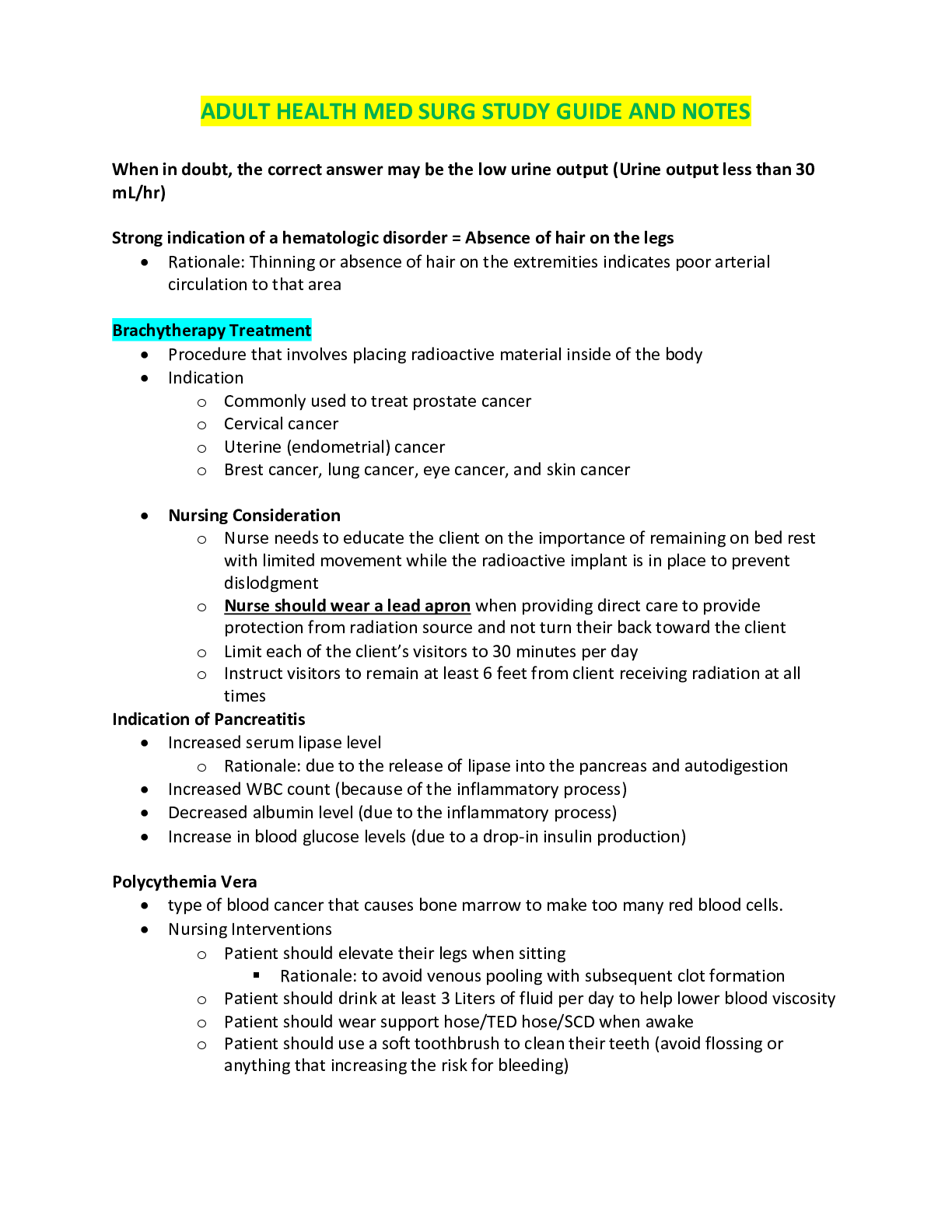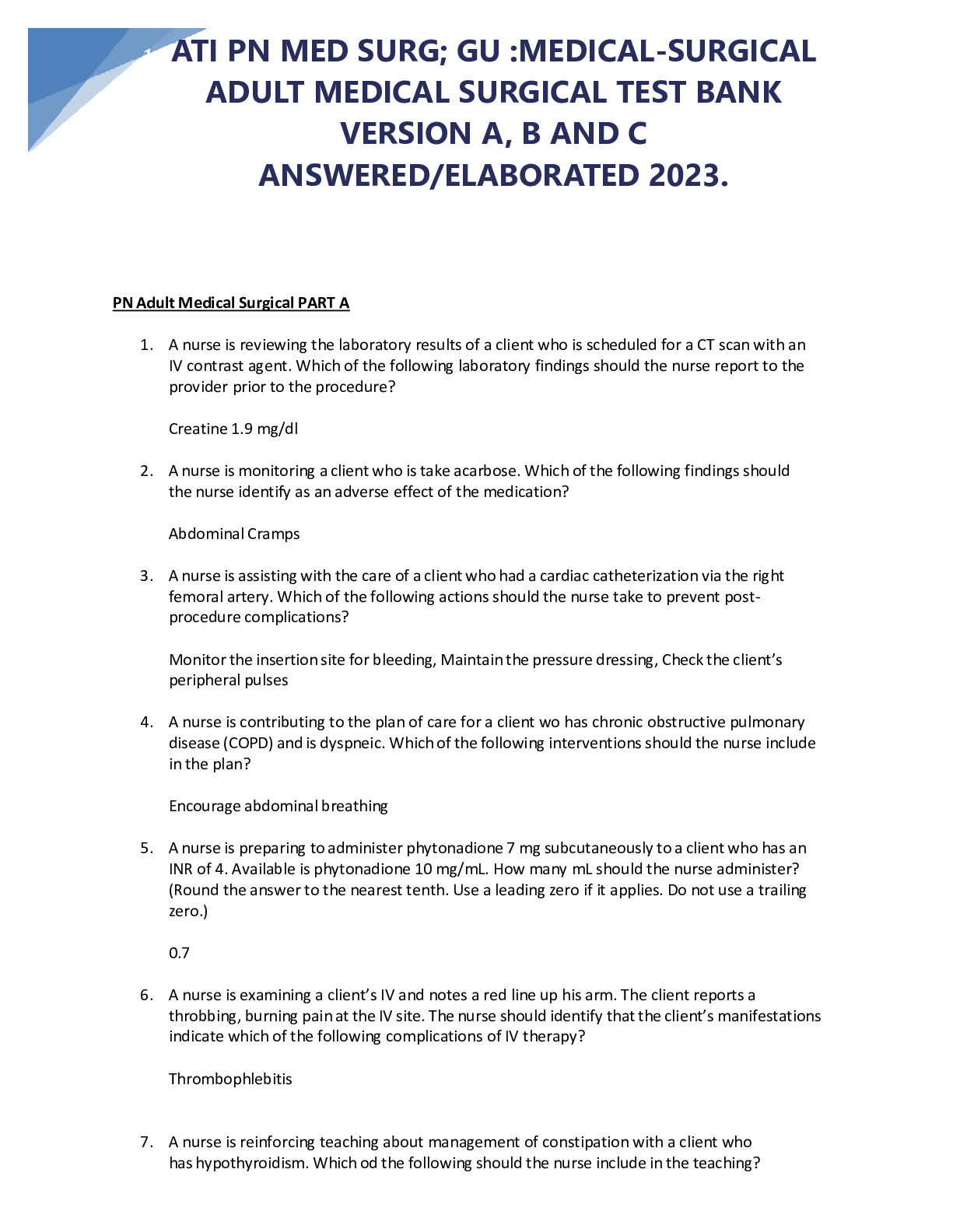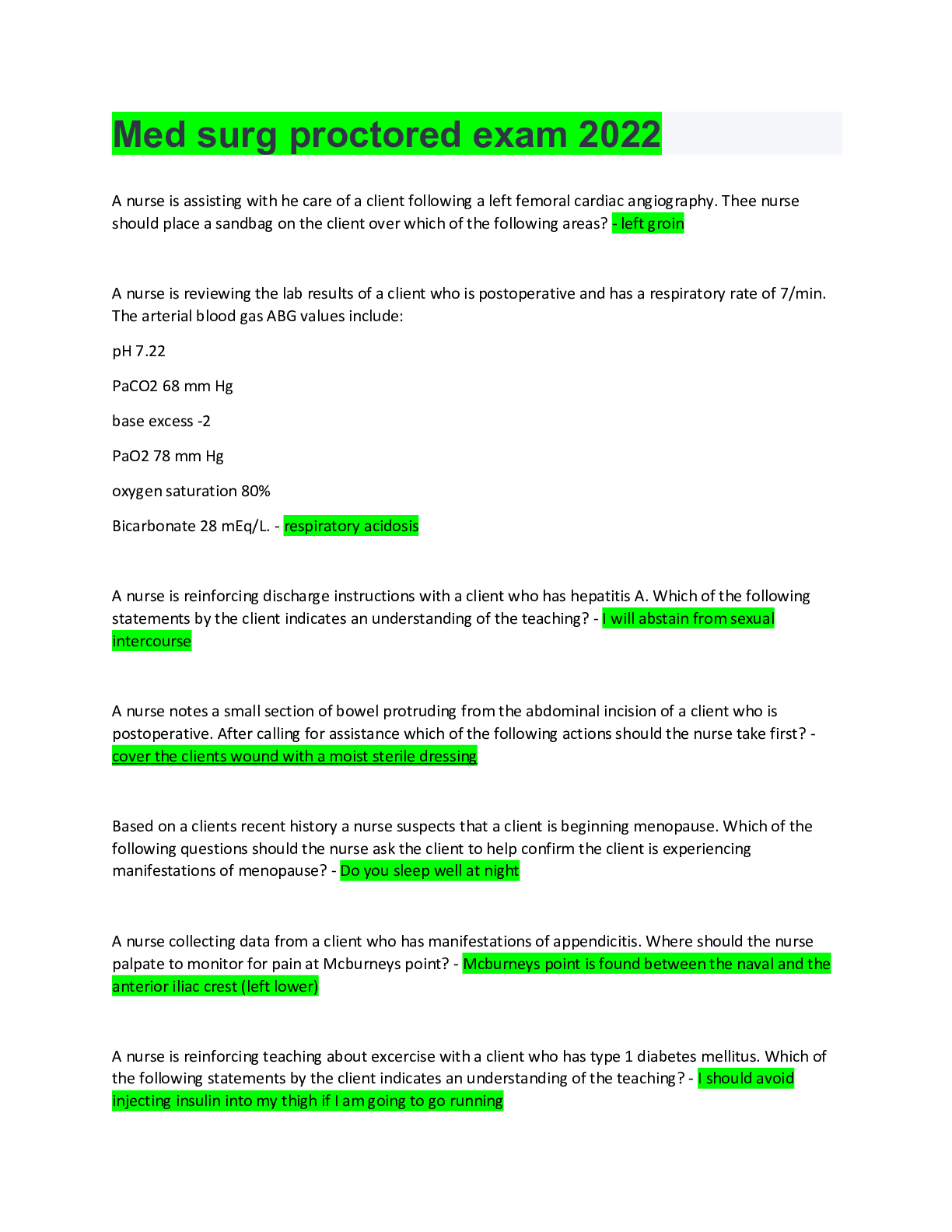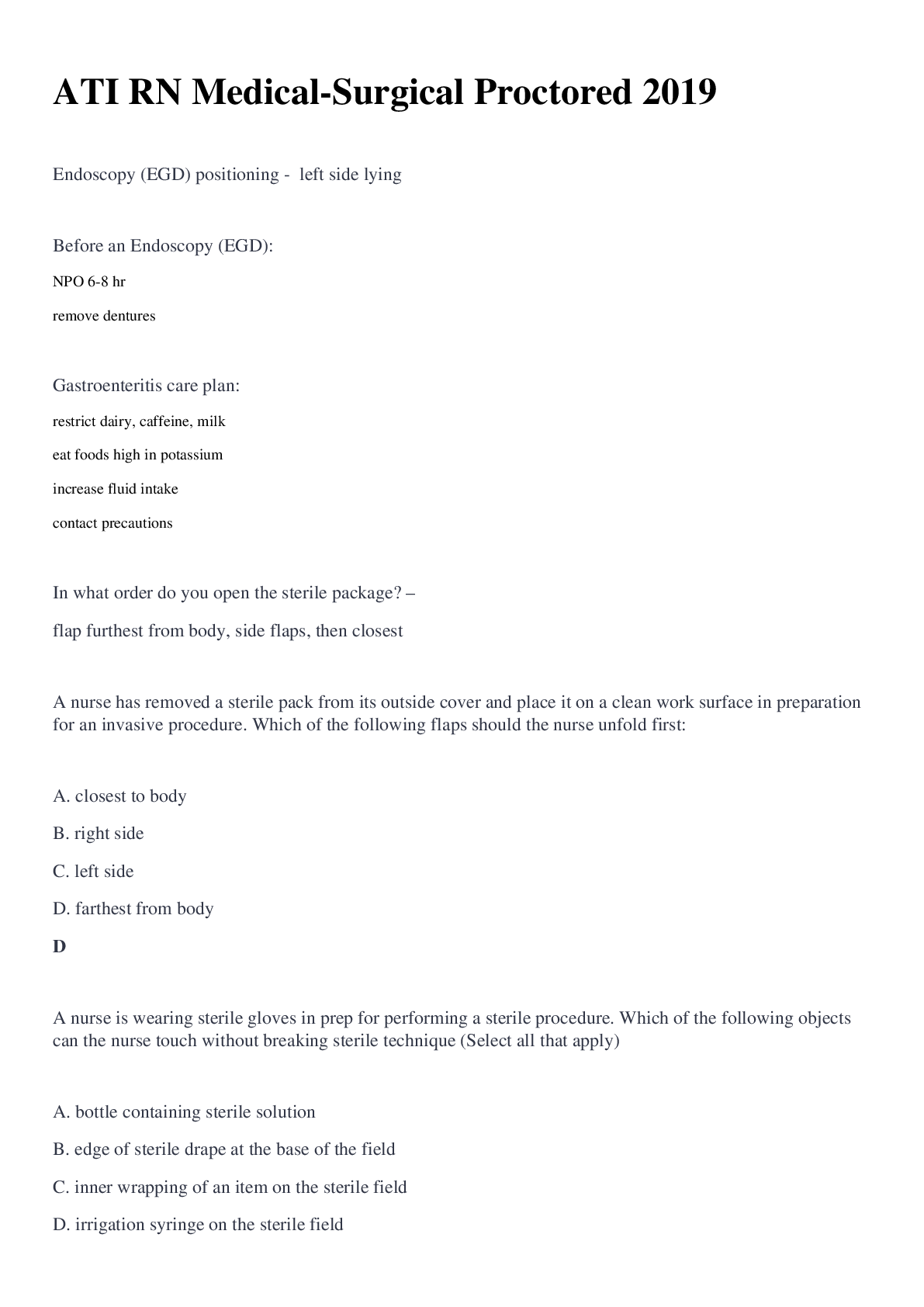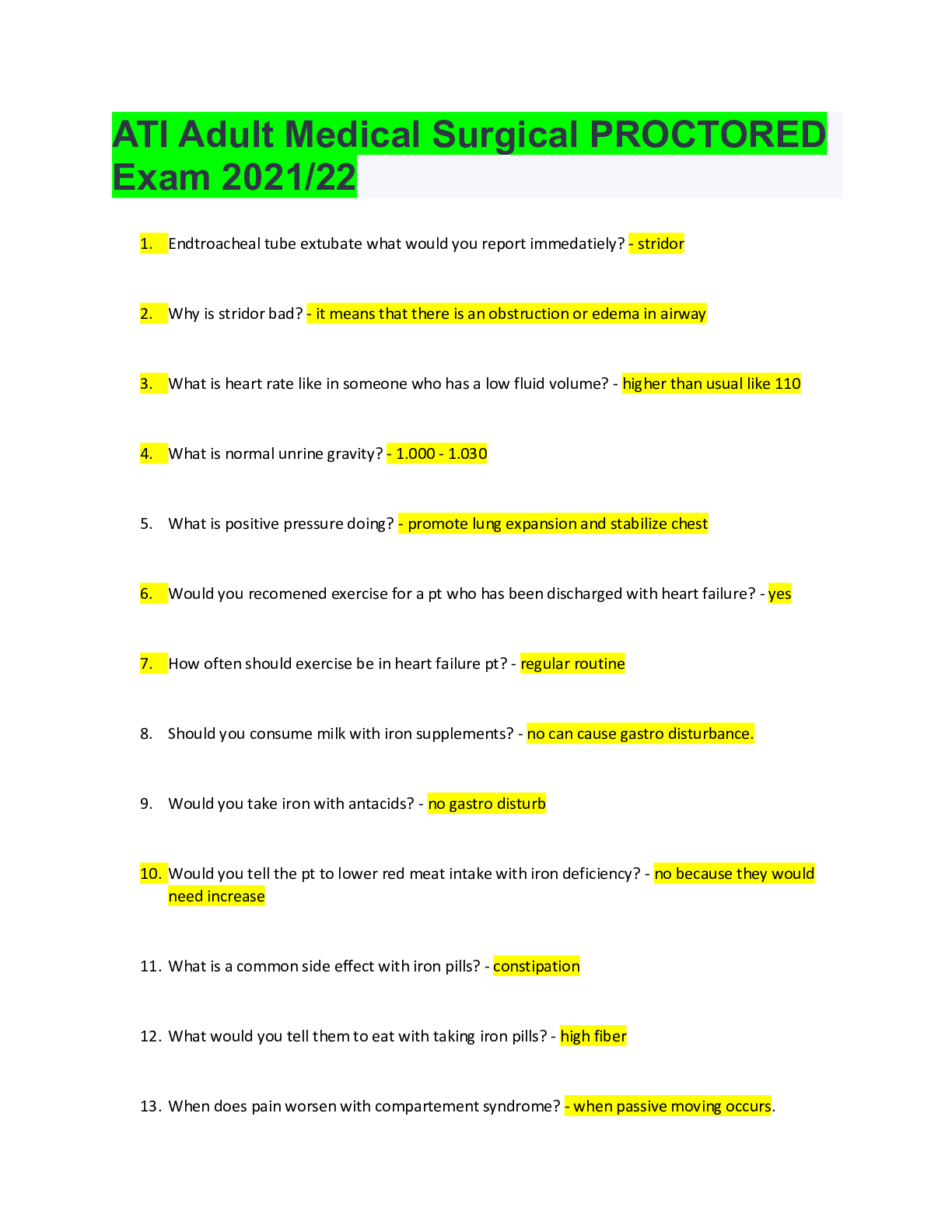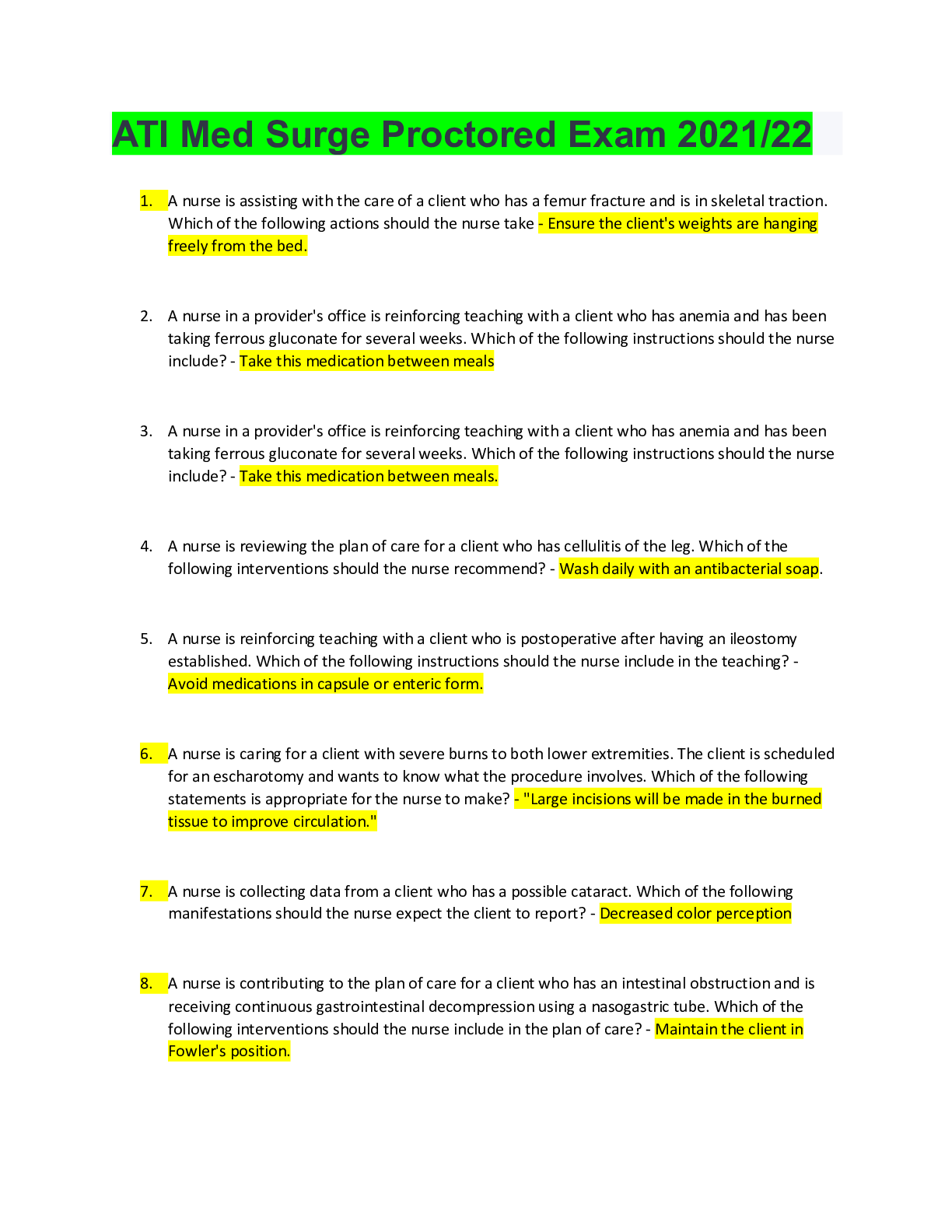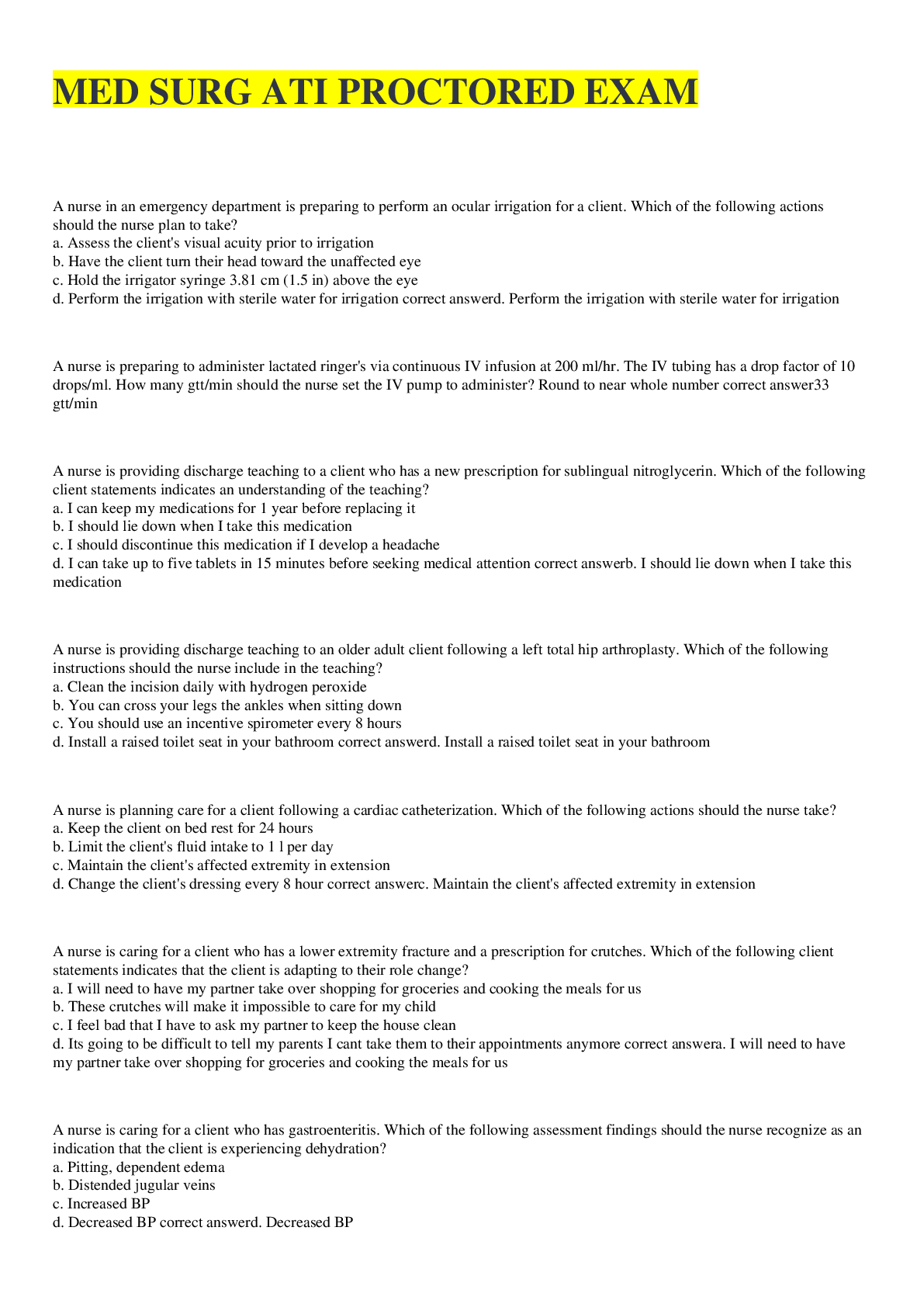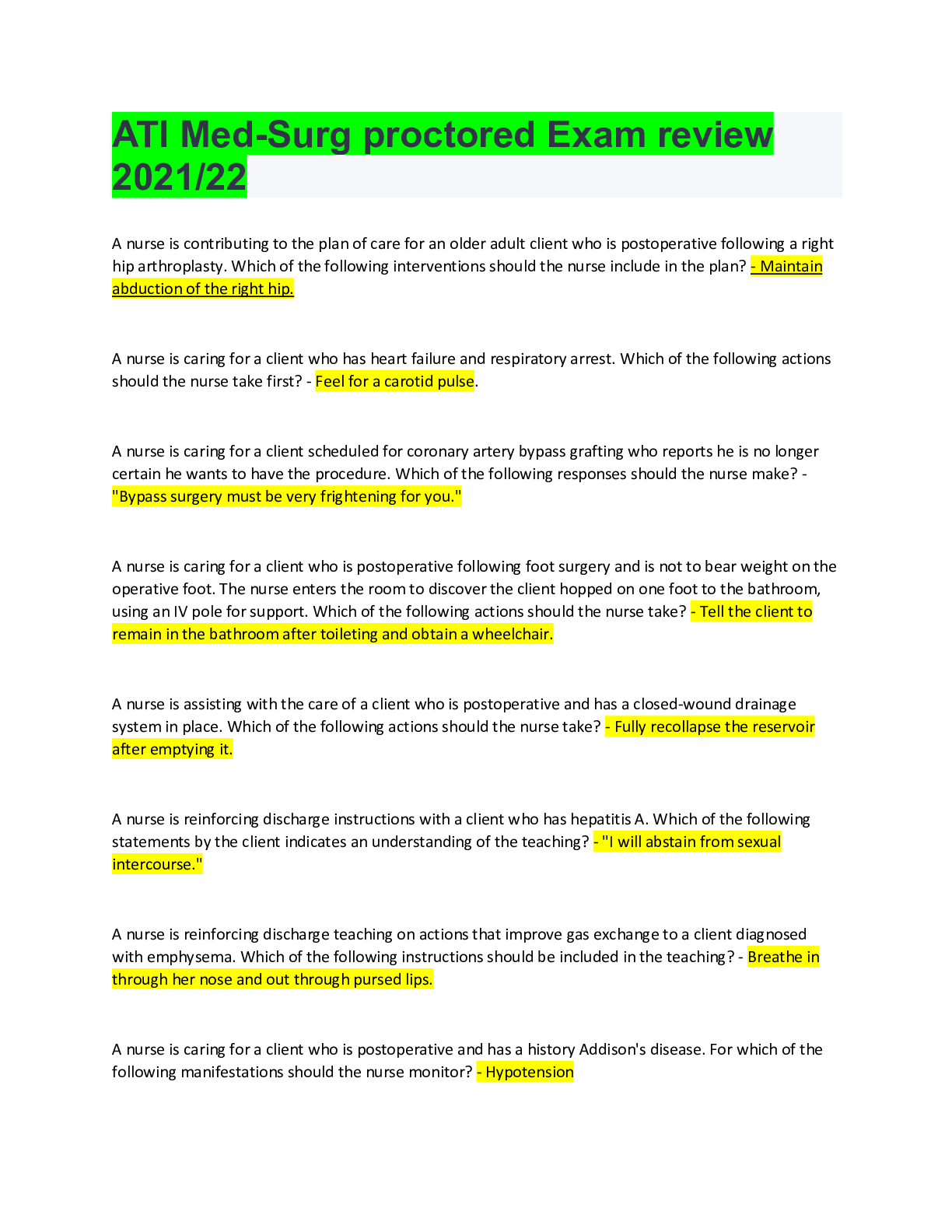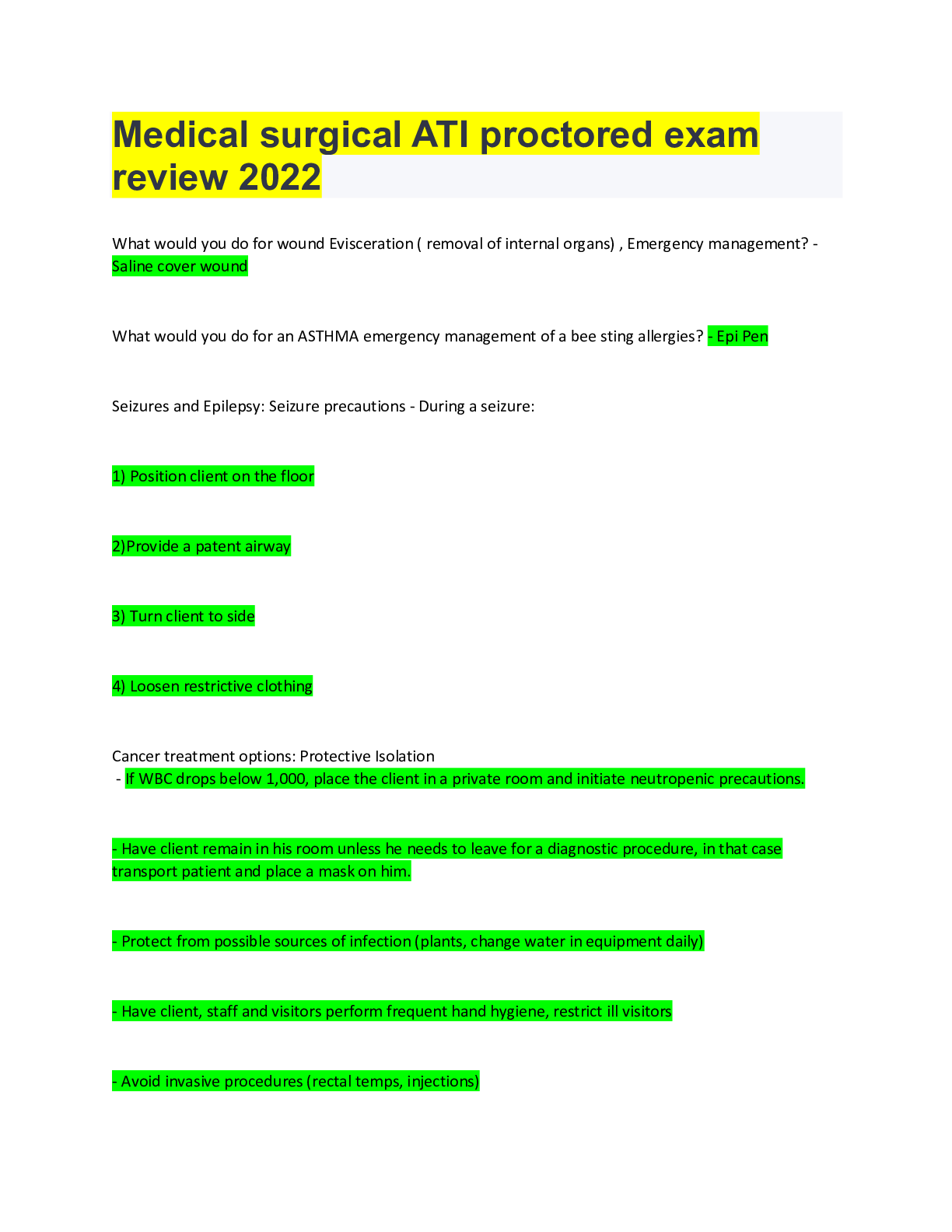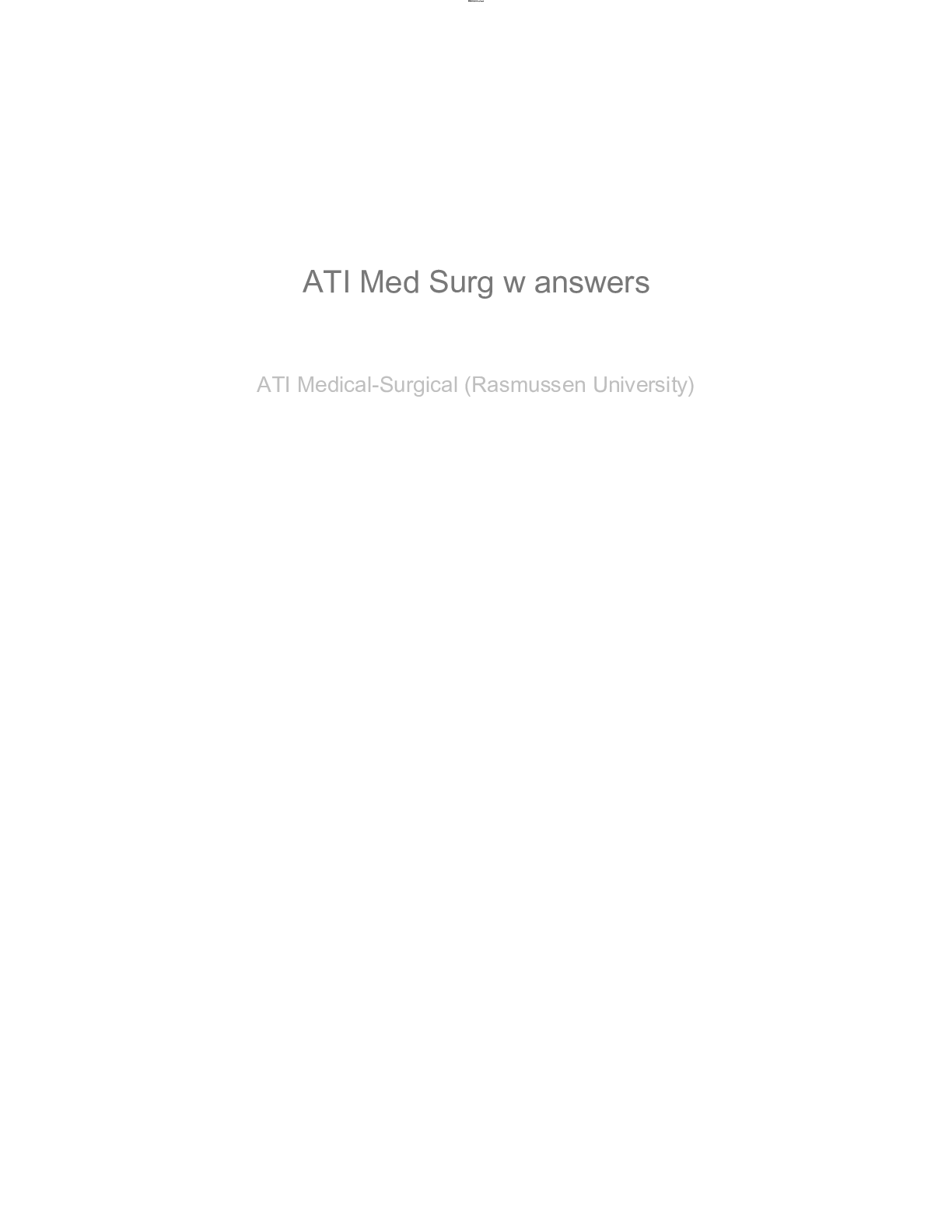*NURSING > MED-SURG EXAM > HESI Med Surg 1 Questions with accurate answers. Rated A. latest update. (All)
HESI Med Surg 1 Questions with accurate answers. Rated A. latest update.
Document Content and Description Below
HESI Med Surg 1 Questions with accurate answers. Rated A. latest update. The nurse observes ventricular fibrillation on telemetry and, on entering the client's bathroom, finds the client unconsci... ous on the floor. Which intervention should the nurse implement first? A. Administer an antidysrhythmic medication. B. Start cardiopulmonary resuscitation. C. Defibrillate the client at 200 J. D. Assess the client's pulse oximetry. - ✔✔B. Start cardiopulmonary resuscitation. Rationale: Ventricular fibrillation is a life-threatening dysrhythmia, and CPR should be started immediately (B). (A and C) are appropriate, but CPR is the priority action. The client is dying, and (D) does not address the seriousness of this situation. The nurse assesses a client who has been prescribed furosemide (Lasix) for cardiac disease. Which electrocardiographic change would be a concern for a client taking a diuretic? A. Tall, spiked T waves B. A prolonged QT interval C. A widening QRS complex D. Presence of a U wave - ✔✔D. Presence of a U wave Rationale: A U wave (D) is a positive deflection following the T wave and is often present with hypokalemia (low potassium level). (A, B, and C) are all signs of hyperkalemia. A 43-year-old homeless, malnourished female client with a history of alcoholism is transferred to the ICU. She is placed on telemetry, and the rhythm strip shown is obtained. The nurse palpates a heart rate of 160 beats/min, and the client's blood pressure is 90/54 mm Hg. Based on these findings, which IV medication should the nurse administer? A. Amiodarone (Cordarone) B. Magnesium sulfate C. Lidocaine (Xylocaine) D. Procainamide (Pronestyl) - ✔✔B. Magnesium sulfate Rationale: Because the client has chronic alcoholism, she is likely to have hypomagnesemia. (B) is the recommended drug for torsades de pointes, which is a form of polymorphic ventricular tachycardia (VT) usually associated with a prolonged QT interval that occurs with hypomagnesemia. (A and D) increase the QT interval, which can cause the torsades to worsen. (C) is the antiarrhythmic of choice in most cases of drug-induced monomorphic VT, not torsades. When developing a discharge teaching plan for a client after the insertion of a permanent pacemaker, the nurse writes a goal of "The client will verbalize symptoms of pacemaker failure." Which behavior indicates that the goal has been met? A. The client demonstrates the procedures to change the rate of the pacemaker using a magnet. B. The client carries a card in his wallet stating the type and serial number of the pacemaker. C. The client tells the nurse that it is important to report redness and tenderness at the insertion site. D. The client states that changes in the pulse and feelings of dizziness are significant changes. - ✔✔D. The client states that changes in the pulse and feelings of dizziness are significant changes. Rationale: Changes in pulse rate and/or rhythm may indicate pacer failure. Feelings of dizziness may be caused by a decreased heart rate, leading to decreased cardiac output (D). The rate of a pacemaker is not changed by a client, although the client may be familiar with this procedure as explained by his health care provider (A). (B) is an important step in preparing the client for discharge but does not demonstrate knowledge of the symptoms of pacer failure. (C) indicates symptoms of possible incisional infection or irritation but do not indicate pacer failure. The nurse teaches a client with type 2 diabetes nutritional strategies to decrease obesity. Which food item(s) chosen by the client indicates understanding of the teaching? (Select all that apply.) A. White bread B. Salmon C. Broccoli D. Whole milk E. Banana - ✔✔B Salmon C Broccoli E. Banana Rationale: (B, C, and E) provide fresh fruits, lean meats and fish, vegetables, whole grains, and low-fat dairy products. All are recommended by the American Diabetes Association (ADA) and are a part of the My Plate guidelines recommended by the U.S. Department of Agriculture (USDA). Whole milk (D) is high in fat and is not recommended by ADA. White bread is milled, a process that removes the essential nutrients. It should be avoided for weight loss and is a poor choice for the client with diabetes (A). A client diagnosed with angina pectoris complains of chest pain while ambulating in the hallway. Which action should the nurse implement first? A. Support the client to a sitting position. B. Ask the client to walk slowly back to the room. C. Administer a sublingual nitroglycerin tablet. D. Provide oxygen via nasal cannula. - ✔✔A. Support the client to a sitting position. Rationale: The nurse should safely assist the client to a resting position (A) and then perform (C and D). The client must cease all activity immediately, which will decrease the oxygen requirement of the myocardial muscle. After these interventions are implemented, the client can be escorted back to the room via wheelchair or stretcher (B). After attending a class on reducing cancer risk factors, a client selects bran flakes with 2% milk and orange slices from a breakfast menu. In evaluating the client's learning, the nurse affirms that the client has made good choices and makes what additional recommendation? A. Switch to skim milk. B. Switch to orange juice. C. Add a source of protein. D. Add herbal tea. - ✔✔A. Switch to skim milk. Rationale: Dietary recommendations to reduce cancer risk include reduced consumption of fats, with increased consumption of fruits, vegetables, and fiber. (A) promotes reduced fat consumption. Orange slices provide more fiber than orange juice (B, C, and D) are not standard recommendations for reducing cancer risk. A nurse is assisting an 82-year-old client with ambulation and is concerned that the client may fall. Which area contains the older person's center of gravity? A. Head and neck B. Upper torso C. Bilateral arms D. Feet and legs - ✔✔B. Upper torso Rationale: Stooped posture results in the upper torso (B) becoming the center of gravity for older persons. The center of gravity for adults is the hips. However, as a person grows older, a stooped posture is common because of changes caused by osteoporosis and normal bone degeneration. Furthermore, the knees, hips, and elbows flex. The head and neck (A) and feet and legs (D) are not the center of gravity in the older adult. Although the arms (C) comprise a part of the upper torso, they do not reflect the best and most complete answer. The nurse receives the client's next scheduled bag of TPN labeled with the additive NPH insulin. Which action should the nurse implement? A. Hang the solution at the current rate. B. Refrigerate the solution until needed. C. Prepare the solution with new tubing. D. Return the solution to the pharmacy. - ✔✔D. Return the solution to the pharmacy. Rationale: Only regular insulin is administered by the IV route, so the TPN solution containing NPH insulin should be returned to the pharmacy (D). (A, B, and C) are not indicated because the solution should not be administered. A male client has just undergone a laryngectomy and has a cuffed tracheostomy tube in place. When initiating bolus tube feedings postoperatively, when should the nurse inflate the cuff? A. Immediately after feeding B. Just prior to tube feeding C. Continuous inflation is required D. Inflation is not required - ✔✔B. Just prior to tube feeding The cuff should be inflated before the feeding to block the trachea and prevent food from entering (B) if oral feedings are started while a cuffed tracheostomy tube is in place. It should remain inflated throughout the feeding to prevent aspiration of food into the respiratory system. (A and D) place the client at risk for aspiration. (C) places the client at risk for tracheal wall necrosis. The nurse is caring for a client with a fractured right elbow. Which assessment finding has the highest priority and requires immediate intervention? A. Ecchymosis over the right elbow area B. Deep unrelenting pain in the right arm C. An edematous right elbow D. The presence of crepitus in the right elbow - ✔✔B. Deep unrelenting pain in the right arm Rationale: Compartment syndrome is a condition involving increased pressure and constriction of the nerves and vessels within an anatomic compartment, causing pain uncontrolled by opioids, and neurovascular compromise (B). (A) is an expected finding. (C) related to compartment syndrome cannot be seen, and any visible edema is an expected finding related to the injury. (D) is an expected finding. Based on the clinical manifestations of Cushing's syndrome, which nursing intervention would be appropriate for a client who is newly diagnosed with Cushing's syndrome? A. Monitor blood glucose levels daily. B. Increase intake of fluids high in potassium. C. Encourage adequate rest between activities. D. Offer the client a sodium-enriched menu. - ✔✔A. Monitor blood glucose levels daily. Rationale: Cushing's syndrome results from a hypersecretion of glucocorticoids in the adrenal cortex. Clients with Cushing's syndrome often develop diabetes mellitus. Monitoring of serum glucose levels (A) assesses for increased blood glucose levels so that treatment can begin early. A common finding in Cushing's syndrome is generalized edema. Although potassium is needed, it is generally obtained from food intake, not by offering potassium-enhanced fluids (B). Fatigue is usually not an overwhelming factor in Cushing's syndrome, so an emphasis on the need for rest (C) is not indicated A low-calorie, low-carbohydrate, low-sodium diet is not recommended (D). Which description of symptoms is characteristic of a client diagnosed with trigeminal neuralgia (tic douloureux)? A. Tinnitus, vertigo, and hearing difficulties B. Sudden, stabbing, severe pain over the lip and chin C. Unilateral facial weakness and paralysis D. Difficulty in chewing, talking, and swallowing - ✔✔B. Sudden, stabbing, severe pain over the lip and chin Trigeminal neuralgia is characterized by paroxysms of pain, similar to an electric shock, in the area innervated by one or more branches of the trigeminal nerve (cranial V) (B). (A) would be characteristic of Ménière's syndrome (cranial nerve VIII). (C) would be characteristic of Bell's palsy (cranial nerve VII). (D) would be characteristic of disorders of the hypoglossal (cranial nerve XII). During assessment of a client in the intensive care unit, the nurse notes that the client's breath sounds are clear on auscultation, but jugular vein distention and muffled heart sounds are present. Which intervention should the nurse implement? A. Prepare the client for a pericardial tap. B. Administer intravenous furosemide (Lasix). C. Assist the client to cough and breathe deeply. D. Instruct the client to restrict the oral fluid intake. - ✔✔A. Prepare the client for a pericardial tap. The client is exhibiting symptoms of cardiac tamponade, a collection of fluid in the pericardial sac that results in a reduction in cardiac output, which is a potentially fatal complication of pericarditis. Treatment for tamponade is a pericardial tap (A). Lasix IV is not indicated for treatment of pericarditis (B). Because the client's breath sounds are clear, (C) is not a priority. Fluids are frequently increased (D) in the initial treatment of tamponade to compensate for the decrease in cardiac output, but this is not the same priority as (A). An older male client comes to the outpatient clinic complaining of pain in his left calf. The nurse notices a reddened area on the calf of his right leg that is warm to the touch, and the nurse suspects that the client may have thrombophlebitis. Which additional assessment is most important for the nurse to perform? A. Measure the client's calf circumference. B. Auscultate the client's breath sounds. C. Observe for ecchymosis and petechiae. D. Obtain the client's blood pressure. - ✔✔B. Auscultate the client's breath sounds. Rationale: All these techniques provide useful assessment data. The most important is to auscultate the client's breath sounds (B) because the client may have a pulmonary embolus secondary to the thrombophlebitis. (A) may provide data that support the nurse's suspicion of thrombophlebitis. (C) is the least helpful assessment because bruising is not a typical finding associated with thrombophlebitis. (D) is always useful in evaluating the client's response to a problem but is of less immediate priority than breath sound auscultation. During the change of shift report, the charge nurse reviews the infusions being received by clients on the oncology unit. The client receiving which infusion should be assessed first? A. Continuous IV infusion of magnesium B. One-time infusion of albumin C. Continuous epidural infusion of morphine D. Intermittent infusion of IV vancomycin - ✔✔C. Continuous epidural infusion of morphine All four of these clients have the potential to have significant complications. The client with the morphine epidural infusion (C) is at highest risk for respiratory depression and should be assessed first. (A) can cause hypotension. The client receiving (B) is at lowest risk for serious complications. Although (D) can cause nephrotoxicity and phlebitis, these problems are not as immediately life threatening as (C). One day after a Billroth II surgery, a male client suddenly grabs his right chest and becomes pale and diaphoretic. Vital signs are assessed as blood pressure 100/80 mm Hg, pulse 110 beats/min, and respirations 36 breaths/min. Which action is most important for the nurse to take? A. Provide a paper bag for his hyperventilation. B. Administer a prescribed PRN analgesic. C. Have the client drink a glass of sweetened fruit juice. D. Apply oxygen at 2 L via nasal cannula. - ✔✔D. Apply oxygen at 2 L via nasal cannula. Rationale: Pulmonary embolism and pneumothorax are risks associated with major abdominal surgery. The nurse should immediately provide oxygen while performing further assessment (D). A rapid respiratory rate should not be treated as hyperventilation (A). (B) should not be administered until more ominous causes are ruled out or treated. There is no evidence that the client is hypoglycemic (C). A hospitalized client is receiving nasogastric tube feedings via a small-bore tube and a continuous pump infusion. He begins to cough and produces a moderate amount of white sputum. Which action should the nurse take first? A. Auscultate the client's breath sounds. B. Turn off the continuous feeding pump. C. Check placement of the nasogastric tube. D. Measure the amount of residual feeding. - ✔✔B. Turn off the continuous feeding pump Rational: A productive cough may indicate that the feeding has been aspirated. The nurse should first stop the feeding (B) to prevent further aspiration. (A, C, and D) should all be performed before restarting the tube feeding if no evidence of aspiration is present and the tube is in place. Which consideration is most important when the nurse is assigning a room for a client being admitted with progressive systemic sclerosis (scleroderma)? A. Provide a room that can be kept warm. B. Make sure that the room can be kept dark. C. Keep the client close to the nursing unit. D. Select a room that is visible from the nurses' desk. - ✔✔A. Provide a room that can be kept warm. Abnormal blood flow in response to cold (Raynaud's phenomenon) is precipitated (A) in clients with scleroderma. (B) is not a significant factor. Stress can also precipitate the severe pain of Raynaud's phenomenon, so a quiet environment is preferred to (C), which is often very noisy. (D) is not necessary. A resident in a long-term care facility is diagnosed with hepatitis B. Which intervention should the nurse implement with the staff caring for this client? A. Determine if all employees have had the hepatitis B vaccine series. B. Explain that this type of hepatitis can be transmitted when feeding the client. C. Assure the employees that they cannot contract hepatitis B when providing direct care. D. Tell the employees that wearing gloves and a gown are required when providing care. - ✔✔A. Determine if all employees have had the hepatitis B vaccine series. Hepatitis B vaccine should be administered to [Show More]
Last updated: 1 year ago
Preview 1 out of 41 pages
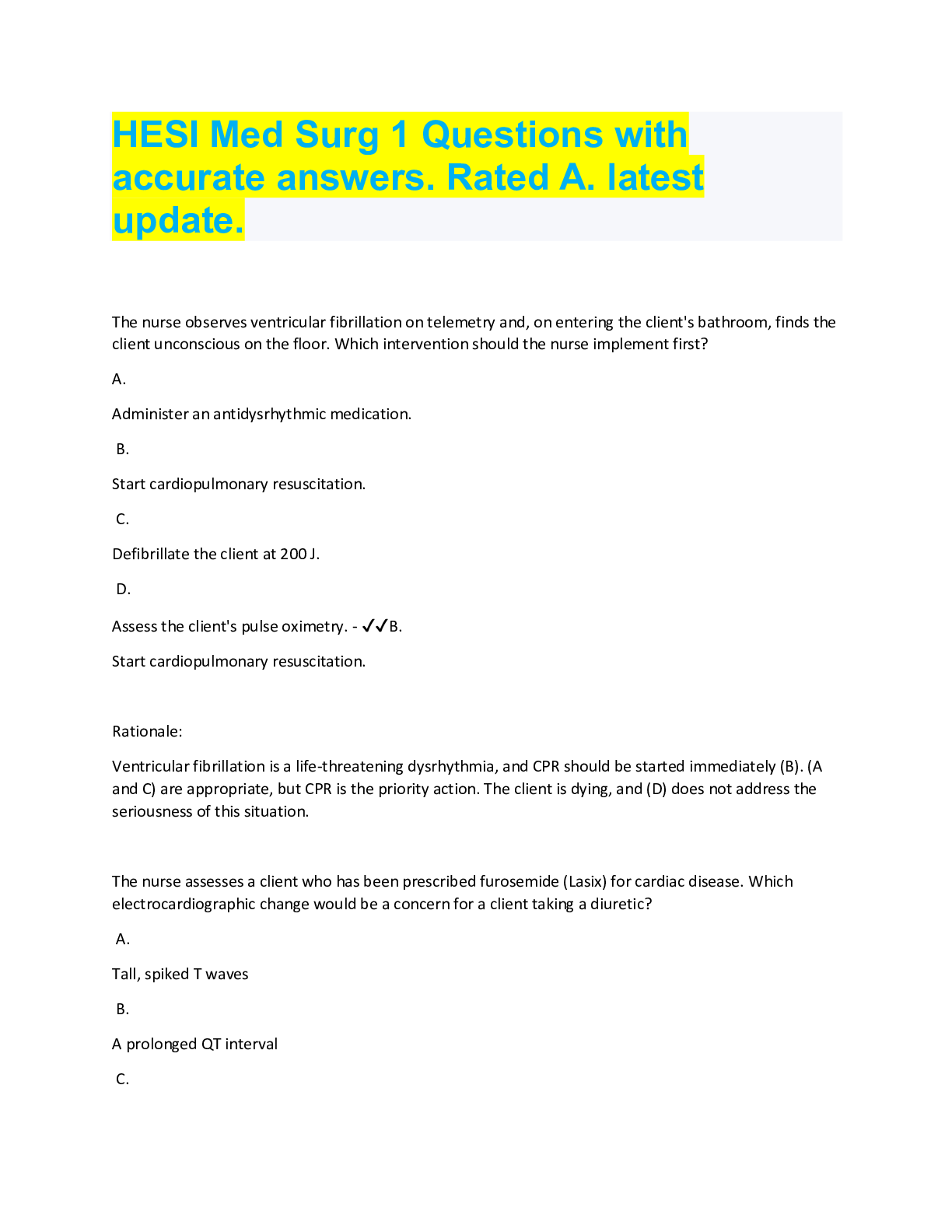
Reviews( 0 )
Document information
Connected school, study & course
About the document
Uploaded On
Oct 05, 2022
Number of pages
41
Written in
Additional information
This document has been written for:
Uploaded
Oct 05, 2022
Downloads
0
Views
78

